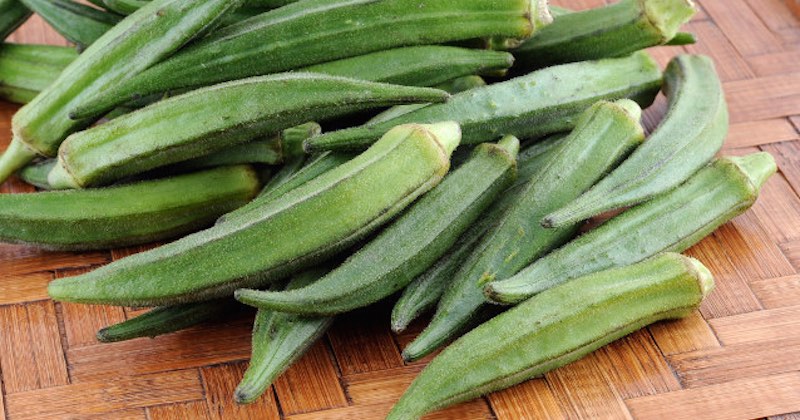Health Benefits of Okra (Lady’s Fingers)
Last updated on
Okra is also known as “lady’s finger” in some parts of Asia. And various other names in other parts of the world. The plant is cultivated in tropical, subtropical and warm temperate regions around the world.
Okra is an edible pea pod and can be eaten raw. It is an acquired raw taste and you may like the crunchiness. You can lightly blanch, steam or give it a quick stir-fry to reduce the “green” taste.
Use when it’s tender, as it gets very fibrous when it’s older. In the okra pods, the white soft seeds (edible) are arranged in 5 to 10 vertical columns, giving it the angled appearance on the outside.
Nutritional Benefits Of Okra
Okra is very low in calories and dense with nutrients. It is high in fiber, vitamin A, C, and folate content.
It is also a good source of the B vitamins, vitamin K, calcium, potassium, iron, zinc, and traces of magnesium and manganese.
Okra is one of those few vegetables which have the highest content of phytonutrients and antioxidants such as beta-carotene, xanthin and lutein.
Health Benefits Of Okra
Okra is one of the best medicinal vegetable although it is not everyone’s favorite. You may like to try it if you knew about its immense health benefits:
Anemia: Helps red blood cells production and prevent anemia.
Anti-Cancer: The high antioxidants in okra helps protect the immune system against harmful free radicals and prevent mutation of cells.
Asthma: The high antioxidants and vitamin C content make okra useful for reducing asthmatic attacks.
Bone Strength: Folate in okra builds strong bones and density, preventing osteoporosis.
Cholesterol: The soluble fiber helps to lower serum cholesterol, thus also reducing atherosclerosis and the risk of heart diseases.
Constipation: The rich fiber and mucilaginous (slimy) content in okra pods help increase bulk, bind to toxins and ensure easy bowel movements with its natural laxative properties. Regularly eating okra also reduces the risk of colon cancer.
Diabetes: It has insulin-like properties that help to reduce blood sugar level. Eat about 6-8 young, raw okra every day and see your blood sugar level drop significantly.
Gut flora: The fiber helps improve the population of beneficial bacteria in the gut.
Immune Booster: The high antioxidants and vitamin C content make okra a good immune booster food that reduce your catching the cough and cold.
Peptic Ulcers: The mucilaginous content provides a temporary coating to the digestive tract and stomach lining while healing the ulcers.
Pregnancy: The rich folate content in okra can help decrease the incidence of neural tube defects in babies.
Skin Health: With good bowel movements, skin health will improve. Helps reduce acne, psoriasis and other skin conditions.
Vision Health: Okra contains beta-carotenes (precursor of vitamin A), xanthin and lutein, all antioxidant properties that are helpful for vision health, preventing eye problems like cataract and glaucoma.
How To Eat Okra To Lower Blood Sugar Levels
Take 3-4 pieces of tender, raw okra, cut off the stem part, make a slit to expose the insides of the okra and cut the okra into two pieces each or more.
Submerge them into a glass of water. Distilled water is best as it will carry all the nutrients into your cells directly. I put them in a mason jar, put on the lid and let it stand overnight out at room temperature.
Next morning, drink the okra water. You may eat the okra or discard it. You will see significant drop in your blood sugar level within 2-4 weeks. It is advisable too, however, to eat clean if you have diabetes, in order to see a lasting result.
Consumption Tips
Choose smaller-sized okra over the big ones. The feel should be crisp and firm to be sure they are tender and not overly fibrous. Avoid those which color does not look fresh and are soft.
As with most vegetables, okra may be subject to insecticide/pesticides. Buy organic if possible. If not, soak okra in water with apple cider vinegar and seasalt for about 10 minutes, then rinse thoroughly.
Cut off the tops and cut okra into smaller pieces of 2-3 inches if desired. Lightly blanch, steam or quickly stir-fry to reduce the mucilage and the “green taste”. It can be added into your salad, or dipped into your home-made chilli sauce, or eat it just on its own.
Okra cannot be juiced due to its very fibrous texture and mucilaginous (slimy) content.
Cautionary Note
Like most vegetables, okra has a small amount of oxalic acid and does not generally bother. Avoid okra if you have a history of kidney stones.
Some of the links I post on this site are affiliate links. If you go through them to make a purchase, I will earn a small commission (at no additional cost to you). However, note that I’m recommending these products because of their quality and that I have good experience using them, not because of the commission to be made.



































 JOIN OVER
JOIN OVER
Comments